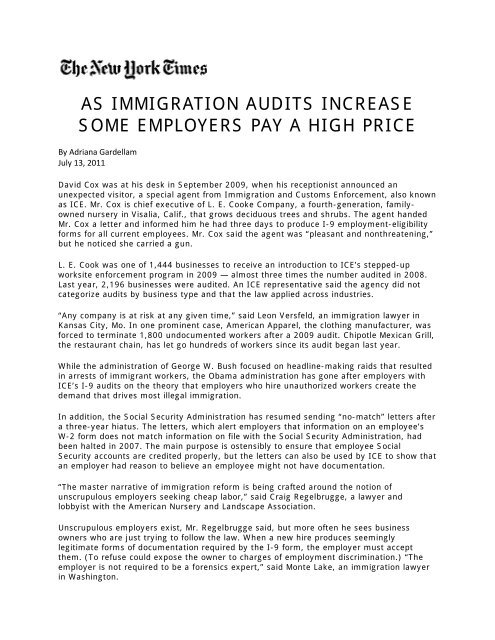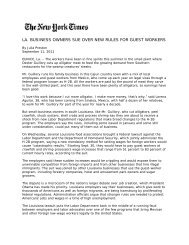as immigration audits increase some employers pay a high price
as immigration audits increase some employers pay a high price
as immigration audits increase some employers pay a high price
You also want an ePaper? Increase the reach of your titles
YUMPU automatically turns print PDFs into web optimized ePapers that Google loves.
AS IMMIGRATION AUDITS INCREASESOME EMPLOYERS PAY A HIGH PRICEBy Adriana GardellamJuly 13, 2011David Cox w<strong>as</strong> at his desk in September 2009, when his receptionist announced anunexpected visitor, a special agent from Immigration and Customs Enforcement, also known<strong>as</strong> ICE. Mr. Cox is chief executive of L. E. Cooke Company, a fourth-generation, familyownednursery in Visalia, Calif., that grows deciduous trees and shrubs. The agent handedMr. Cox a letter and informed him he had three days to produce I-9 employment-eligibilityforms for all current employees. Mr. Cox said the agent w<strong>as</strong> “ple<strong>as</strong>ant and nonthreatening,”but he noticed she carried a gun.L. E. Cook w<strong>as</strong> one of 1,444 businesses to receive an introduction to ICE’s stepped-upworksite enforcement program in 2009 — almost three times the number audited in 2008.L<strong>as</strong>t year, 2,196 businesses were audited. An ICE representative said the agency did notcategorize <strong>audits</strong> by business type and that the law applied across industries.“Any company is at risk at any given time,” said Leon Versfeld, an <strong>immigration</strong> lawyer inKans<strong>as</strong> City, Mo. In one prominent c<strong>as</strong>e, American Apparel, the clothing manufacturer, w<strong>as</strong>forced to terminate 1,800 undocumented workers after a 2009 audit. Chipotle Mexican Grill,the restaurant chain, h<strong>as</strong> let go hundreds of workers since its audit began l<strong>as</strong>t year.While the administration of George W. Bush focused on headline-making raids that resultedin arrests of immigrant workers, the Obama administration h<strong>as</strong> gone after <strong>employers</strong> withICE’s I-9 <strong>audits</strong> on the theory that <strong>employers</strong> who hire unauthorized workers create thedemand that drives most illegal <strong>immigration</strong>.In addition, the Social Security Administration h<strong>as</strong> resumed sending “no-match” letters aftera three-year hiatus. The letters, which alert <strong>employers</strong> that information on an employee’sW-2 form does not match information on file with the Social Security Administration, hadbeen halted in 2007. The main purpose is ostensibly to ensure that employee SocialSecurity accounts are credited properly, but the letters can also be used by ICE to show thatan employer had re<strong>as</strong>on to believe an employee might not have documentation.“The m<strong>as</strong>ter narrative of <strong>immigration</strong> reform is being crafted around the notion ofunscrupulous <strong>employers</strong> seeking cheap labor,” said Craig Regelbrugge, a lawyer andlobbyist with the American Nursery and Landscape Association.Unscrupulous <strong>employers</strong> exist, Mr. Regelbrugge said, but more often he sees businessowners who are just trying to follow the law. When a new hire produces seeminglylegitimate forms of documentation required by the I-9 form, the employer must acceptthem. (To refuse could expose the owner to charges of employment discrimination.) “Theemployer is not required to be a forensics expert,” said Monte Lake, an <strong>immigration</strong> lawyerin W<strong>as</strong>hington.
The upshot of the more aggressive enforcement is that even <strong>employers</strong> who have followedthe rules can be dev<strong>as</strong>tated by an audit that compels them to fire valuable, long-timeemployees.The I-9 audit of Mr. Cox’s nursery revealed that 26 of his 99 employees were not authorizedto work in the United States. Because ICE determined he had acted re<strong>as</strong>onably in hiringthem, Mr. Cox w<strong>as</strong> not fined or held criminally liable. But after confirming that the 26employees could not produce authentic documents, he w<strong>as</strong> forced to fire them. All had beenwith him for five to 10 years, and he lost half of his budding crew, a <strong>high</strong>ly specialized teamthat grafts trees. “Telling them w<strong>as</strong> probably the worst day of my life,” he said. “I don’t justsit at a desk here, I’m actually out in the field harvesting with them.”Mr. Cox said he w<strong>as</strong> lucky the audit hit midrecession, after he had already reduced his workforce and inventory. Still, he estimates that his 2009 expenses climbed 10 percent <strong>as</strong> aresult of the terminations. And, despite California’s <strong>high</strong> unemployment rate, findingreplacement employees h<strong>as</strong> proved challenging. “I’ve gone through more workers this yearthan I have in the p<strong>as</strong>t 10 years combined,” Mr. Cox said.While most such workers earn the $8-an-hour minimum wage in California, Mr. Cox said hegenerally paid $8.90 an hour for a 50-hour week. The terminated budding crew workersmade $10 an hour. Compensation includes state-mandated overtime of time and a half,health insurance and two weeks’ paid vacation. “If I raised the wage,” he said, “I’d have toshut my doors.”Meanwhile, after an audit, ICE does not round up the affected workers for deportation. Thatmeant Mr. Cox’s former workers were free to seek employment elsewhere — including withhis competitors. Mr. Cox said that he knew through his remaining workers that theterminated employees were all working in the area.After the audit, Mr. Cox started using E-Verify, a federal program that lets <strong>employers</strong>confirm the authenticity of a job applicant’s Social Security and green card numberselectronically. Although the program’s use is mandatory in <strong>some</strong> states, its reliability h<strong>as</strong>been debated, and it remains voluntary in California. A bill in Congress that would requireall American <strong>employers</strong> to use the program could go to a vote this month.The owner of another agricultural business, this one on the E<strong>as</strong>t Co<strong>as</strong>t, requestedanonymity because he w<strong>as</strong> currently undergoing an I-9 audit that had resulted in the loss ofhalf of his work force. He said the employees he w<strong>as</strong> forced to terminate were 25 to 40years old and had been in the United States for five to 10 years. Many were raising childrenborn here. “They’re all staying here and working for <strong>some</strong>one else,” he said.After the terminations, the E<strong>as</strong>t Co<strong>as</strong>t owner said he w<strong>as</strong> struggling to get replacementworkers up to speed. He h<strong>as</strong> endured a substantial incre<strong>as</strong>e in customer complaints — to 30a week from about three — and h<strong>as</strong> reduced his 2011 sales goals by 15 percent. Theterminated employees included members of his management team who earned $12 to $15an hour. He paid them all their vacation <strong>pay</strong>, and said he w<strong>as</strong> bothered by the perceptionthat <strong>employers</strong> like him were unscrupulous and treated undocumented workers unfairly.“We did everything by the book,” he said. “There were a lot of tears here.”While the human side of the issue is compelling, <strong>employers</strong> must comply with the law, saidMr. Lake, the <strong>immigration</strong> lawyer. There is no way to avoid an ICE audit, but establishingand maintaining the right procedures can help you survive one. Mr. Lake recommends that2
<strong>employers</strong> review their practices and seek professional <strong>as</strong>sistance if they are notknowledgeable about legal requirements. Sloppy record-keeping can lead to fines fortechnical violations.If a review reveals incomplete I-9 forms, <strong>employers</strong> should fill in the missing informationand initial it with the date and time it w<strong>as</strong> added. Mr. Lake advises random checks to ensurethat employees are completing the forms. Be sure to retain I-9 forms for the legallyrequired period of time — the longer of three years or one year after the employee leavesthe company. Business owners should understand their obligations upon receiving a nomatchletter. Mr. Lake advises <strong>employers</strong> who receive these letters to meet one-on-one withthe designated worker to ensure that a clerical error did not cause the confusion, confirmingthat names are spelled correctly and no numbers have been transposed.Assuming there is no mistake, Mr. Lake said the owner must instruct the worker to pursuethe issue with the Social Security Administration and report back within a “re<strong>as</strong>onable time.”Document your actions and treat all workers the same, Mr. Lake said. If an employeereports that everything is fine, and you get another no-match letter the next year, youknow it is not fine. After that, Mr. Lake said, there is no good answer if ICE conducts anaudit and <strong>as</strong>ks, “Why didn’t you take action the second time?”3



